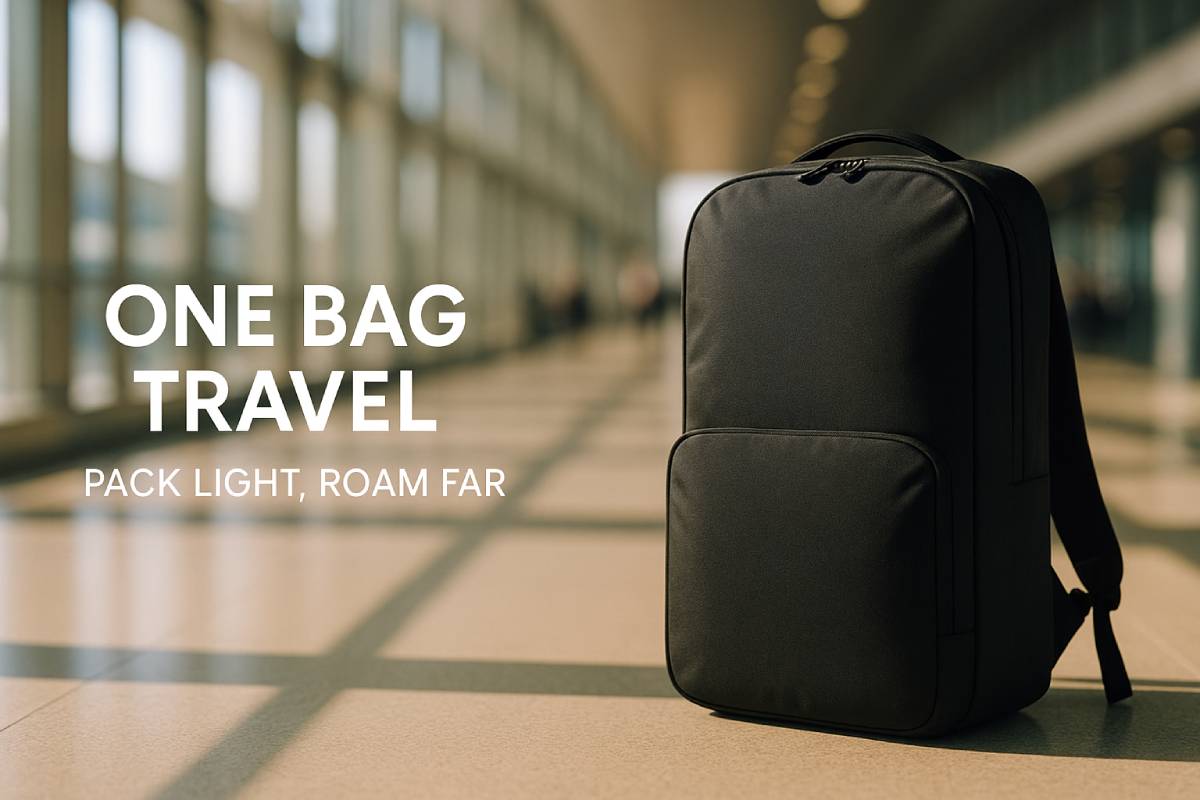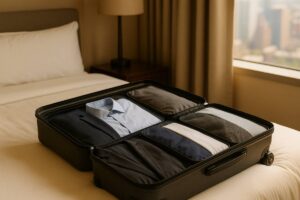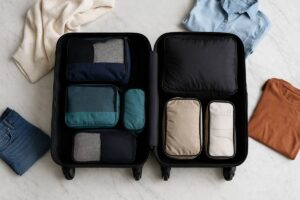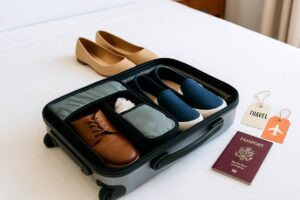Imagine breezing through airports and cobblestone streets with just one carry-on—no baggage carousel queues or costly checked-bag fees to slow you down.
One-bag travel isn’t a fad; it’s a smart strategy embraced by modern explorers who value freedom, efficiency, and simplicity.
By choosing a 30–50 L bag, packing a capsule wardrobe, and mastering space-saving hacks, you’ll unlock stress-free adventures.
From quick-dry merino wool tees to modular packing cubes, each element plays a role in your streamlined setup.
Ready to revolutionize your travels? Let’s dig into the step-by-step guide that turns overpacking into a relic of the past.
Assessing Your Trip Needs
Before you start stuffing everything into your one-bag carry-on, it’s crucial to assess your trip needs—duration, climate, and planned activities—to create a versatile, minimalist packing list. With global leisure trips averaging nearly five days and business trips lasting around 3.8 days on average, your packing blueprint must adapt to different trip lengths.
Considering climate zones—from tropical beaches to temperate cityscapes—guides fabric choices and layering systems, while mapping out planned activities (adventure, wellness, business) ensures you have the right gear without overpacking. A tailored approach balances practicality with versatility, empowering smooth, one-bag travel that’s both efficient and stress-free.
1. Trip Duration
Breaking down trip length into clear categories helps you calculate exactly how many outfits and essentials to bring, avoiding both overpacking and last-minute shopping.
| Duration Category | Days | Typical Use Case | Key Packing Implication |
|---|---|---|---|
| Weekend Getaway | 1–3 | Quick city escapes, short retreats | 2–3 tops, 1–2 bottoms, minimal shoes |
| Short Trip | 4–7 | Standard leisure vacations | 3–4 tops, 2–3 bottoms, layering piece |
| Mid-Length Adventure | 8–14 | Extended road trips, multi-city tours | 4–6 tops, 3–4 bottoms, lightweight jacket |
| Long Haul / Slowcation | 15+ | Immersive stays, nomadic travel | Capsule wardrobe + compact laundry kit |
Global leisure trips average close to five days, while Americans typically take vacations lasting about 6.9 days. Business travelers, on the other hand, average just under four days per trip. Align your clothing count, electronics, and toiletries to these benchmarks to strike the perfect balance between preparedness and portability.
2. Climate Considerations
Understanding the climate zones you’ll traverse ensures you select appropriate fabrics and outerwear, preventing both overheating and chill.
| Climate Zone (Köppen) | Characteristics | Key Fabric Choices & Gear |
|---|---|---|
| A – Tropical | High heat & humidity, heavy rain | Moisture-wicking tees, breathable shorts, sun hat |
| B – Arid/Dry | Hot days, cool nights, little rainfall | Light long-sleeves, UV-protective layers, bandana |
| C – Temperate | Mild summers, cool winters | Versatile layers, packable rain shell |
| D – Continental | Warm summers, cold winters | Insulating mid-layers, waterproof jacket |
| E – Polar | Frigid temperatures, snow/ice | Thermal base layers, insulated outerwear |
The Köppen climate classification groups Earth’s climates into five main types. For tropical zones, include items like a dry bag and bug spray alongside lightweight trousers; for temperate regions, focus on quick-dry layers and a compact raincoat. Matching gear to climate ensures comfort without extra bulk.
3. Activities and Itinerary
Your planned activities define specialized items—think beyond clothes to gear and accessories that support each pursuit.
- Adventure Travel: Mountaineering, trekking, scuba diving, cycling, etc. require durable, moisture-wicking fabrics and compact safety gear.
- Wellness Tourism: Spa-centric trips often involve lightweight loungewear and compact yoga mats; wellness tourists spend on average 35 % more than typical international travelers, highlighting their willingness to invest in comfort.
- Business & Bleisure: Corporate travelers log an average of 22 days per year on the road, with 3.8 days per trip—pack wrinkle-resistant shirts and a slim laptop sleeve to transition seamlessly between work and leisure.
- Shopping & Cultural Tours: If shopping ranks high (90 % of Asians, 86 % of Western Europeans participate), leave room for purchases and include a lightweight foldable tote.
By cross-referencing your trip duration, climate, and activity needs, you’ll build a one-bag packing list that’s lean yet versatile—ready for anything your journey throws at you.
Choosing the Right Bag

Before investing in your next one-bag setup, choosing the right carry-on is crucial: you need a balance of size, durability, and organizational features to keep you mobile and stress-free. Here’s what the data tells us:
- Capacity & Dimensions: Aim for a bag between 30–50 L for weekend trips and up to 50 L if you frequently push the overhead-bin limit. Standard airline carry-on dimensions are 22×14×9 in (totaling 45 linear inches) to fit most overhead bins.
- Durable Materials: Hard-shell suitcases made from 100 % polycarbonate survive repeated drop tests and baseball-bat strikes with minimal scuffs. Soft-sided bags crafted from tightly woven ballistic nylon or polyester resist tears and abrasions while remaining lightweight.
- Organizational Features: Integrated compression straps and panels can reduce volumetric “dead space” by up to 20 % while securing your contents. Multiple interior zip-dividers, external pockets, and dedicated tech sleeves streamline packing and retrieval on the go.
1. Capacity & Dimensions
Choosing a bag with the right volume and external dimensions ensures you hit airline restrictions without sacrificing versatility.
| Trip Length | Recommended Volume | Use Case |
|---|---|---|
| Weekend (1–3 days) | 30–40 L | City escapes, quick retreats |
| Short (4–7 days) | 40–50 L | Standard vacations, bleisure trips |
| Extended (8–14 days) | 50–60 L | Multi-city tours |
- Standard Carry-On Limits: Most airlines cap carry-ons at 22×14×9 in (45 linear inches) and 7–10 kg. Bags larger than this risk gate-checking.
- Backpack vs. Spinner: Backpacks around 27–35 L fit overhead bins and double as personal items; spinners at 39–50 L maximize volume and glide effortlessly on four wheels.
2. Material Durability
Your bag needs to withstand airport handlers, pavement scrapes, and unexpected impacts.
- Polycarbonate Hardshells: In lab drop and baseball-bat tests, polycarbonate suitcases showed only surface scuffs, proving their resilience under abuse. These shells flex under pressure, then spring back, preventing cracks.
- Ballistic Nylon & Polyester: Soft-sided bags made from tightly woven nylon or polyester offer tear resistance and water repellence. High-quality models use YKK zippers and reinforced seams to prevent failures at stress points.
- Warranty & Testing: Top brands back their construction with lifetime warranties. In one 2025 study, luxury and mid-range labels like Monos and TravelPro scored highest for material ruggedness after hundreds of real-world trips.
3. Organizational Features
A well-designed interior can make or break your one-bag strategy, especially when space is at a premium.
| Feature | Benefit |
|---|---|
| Compression Straps | Reduce pack volume by ~20 %; stabilize load |
| Removable Packing Cubes | Keep categories separated; quick unpacking |
| Zippered Dividers | Isolate clean vs. dirty; secure valuables |
| External Quick-Access Pockets | Store essentials like passport and snacks |
- Compression Systems: Dual-zipper compression cubes and interior straps squeeze air out of clothing bundles, reclaiming space while preventing shifting.
- Modular Accessories: Removable cubes and dividers let you swap setups between business, adventure, or beach modes in seconds. Look for bags with built-in laundry sacks or RFID-blocking pockets for extra convenience.
- Ease of Use: Spinner wheels and telescoping handles eliminate wrist strain. For backpacks, padded harnesses and sternum straps distribute weight comfortably on long walks.
Bottom Line: Your ideal carry-on marries a 40–50 L capacity (or up to 35 L if you prefer a backpack), robust materials like polycarbonate or ballistic nylon, and smart interior compression/organizer features. Investing in these attributes guarantees you can condense all your essentials into one sleek bag—no gate checks, no stress, just smooth travel.
Creating a Versatile Packing List
A truly versatile packing list hinges on a lean capsule wardrobe and smart gear choices that adapt to varying climates and activities without weighing you down. Industry data shows seasoned travelers average 14–16 clothing items for trips over five days, while style experts recommend the 5-4-3-2-1 formula—five tops, four bottoms, three pairs of shoes, two layers or dresses, and one accessory—to hit the sweet spot between variety and minimalism.
Meanwhile, the global quick-dry clothing market is booming—valued at $15 billion in 2025 with a projected 7 percent CAGR—underscoring the importance of moisture-wicking fabrics for every itinerary. Layer in multi-purpose essentials (a sarong that doubles as a towel, a pashmina that’s also a blanket) to maximize function without bulk.
1. Capsule Wardrobe Framework
Building a capsule wardrobe means selecting pieces that mix-and-match, layer well, and wick moisture when needed.
| Item Category | Quantity (7-Day Trip) | Why It Works |
|---|---|---|
| Tops | 5 (T-shirts, blouses, merino wool) | Quick-dry fabrics dry overnight; merino resists odor and regulates temperature |
| Bottoms | 4 (Shorts, pants, skirts) | Neutral colors pair with all tops; convertible zip-off pants add versatility |
| Shoes | 3 pairs | Day shoes, dress shoes, lightweight sandals cover all activities |
| Layers/Dresses | 2 (Light jacket, casual dress) | Packable rain shell and a day-to-night dress or tunic; layers adapt to weather |
| Accessories | 1 (Scarf/pashmina) | Doubles as wrap, blanket, pillow; neutral shades match any outfit |
Pro tip: Adjust quantities for trip length—reduce two tops for 4-day stays or add one extra bottom for 10+ days.
2. Essential Gear & Multi-Purpose Items
Beyond clothes, select gear that pulls double (or triple) duty to streamline your one-bag strategy.
| Gear Item | Functionality |
|---|---|
| Packing Cubes | Organize outfits; compress to save ~20 % space |
| Sarong or Turkish Towel | Beach towel, blanket, dress, bag |
| Pashmina/Travel Wrap | Scarf, shawl, travel blanket, pillow |
| Merino Wool Underwear | Odor-resistant, quick-dry base layer |
| Packable Tote/Laundry Bag | Day bag; separates dirty clothes |
| Universal Sink Plug & Soap Sheet | DIY sink wash setup for laundry on-the-go |
| Luggage Scale | Avoid overweight fees; fits in pocket |
| Travel-Size Multi-Tool Wallet | Cards, cash, Swiss-army functions |
| Smartphone Mini-Tripod | Stabilize photos/videos; fits coat pocket |
Insider note: Sarongs and pashminas are among the most versatile travel accessories—used by 80 % of long-haul flyers for warmth and style.
By combining the 5-4-3-2-1 capsule rule, quick-dry performance wear, and multi-purpose gear, you’ll cover every weather scenario and activity—while keeping all your essentials in one bag.
Space-Saving Packing Techniques
Before you reach for that extra sweater or second pair of shoes, mastering space-saving packing techniques can make or break your one-bag strategy. Rolling your garments squeezes out air pockets and tucks neatly into corners, while packing cubes keep everything organized and can compress your load by up to 67 %. Compression bags—from vacuum-style systems to budget-friendly manual roll-up pouches—can further reduce your bulk by as much as 90 %, giving you room for that souvenir and avoiding costly gate checks.
1. Rolling Clothes
Tightly rolling garments is the simplest “hack” yet dramatically improves volumetric efficiency.
- Air-pocket elimination: Rolling squeezes air from between folds, using every cubic inch of your bag.
- Wrinkle management: When done carefully, rolled shirts and tees resist creases better than haphazard folding.
- Proven results: One TikToker fit two weeks’ worth of outfits into a single carry-on using rolling plus packing cubes.
2. Packing Cubes
These zip-pered pouches transform chaotic piles into neat, compressed bundles—ideal for capsule wardrobes.
| Cube Size | Compression Ratio | Organizational Benefit |
|---|---|---|
| Medium | ~67 % volume reduction | Perfect for tops, pants, or layered pieces |
| Large | ~60 % volume reduction | Accommodates bulkier items like sweaters or jeans |
| Any size | ~30 % average space saved | Keeps like-items together; speeds up unpacking |
| Any size | ~25 % space saved (Peak Design cubes) | Slim profile fits into backpacks and suitcases |
- Visibility & access: Mesh panels and dedicated compartments prevent “black hole” moments when you need that one pair of socks.
- Modular use: Swap cubes between work trips and beach vacations in seconds—no extra sorting required.
3. Compression Bags
For peak space savings, compression bags use hand-rolling or vacuum seals to flatten and shrink bulky items.
| Bag Type | Space Reduction | Details |
|---|---|---|
| Hibag Manual Bags | Up to 75 % | Roll-out design, no pump needed—ideal for undergarments to jackets |
| Biaggi Compression | Up to 90 % | Airtight seal; pushes out nearly all air for maximum volume savings |
| Travelon Compression | Up to 80 % | Clear, reusable, security-friendly; perfect for laundry separation |
| Kmart Budget Bags | ~30 % | Low-cost solution praised by travelers for extra carry-on capacity |
- Bulk items tamed: Great for outwear, towels, or sleeping bags—transforms a puffy coat into a flat layer.
- Dual use: On the return trip, segregate dirty laundry without compromising fresh clothes.
By combining rolling, packing cubes, and compression bags, you’ll unlock true one-bag travel freedom: more room, less weight, and instant organization—so you can focus on adventures, not baggage claims.
Understanding Airline Size and Weight Restrictions
Standardizing your carry-on to fit within airline-mandated dimensions and weight thresholds is the single best way to avoid gate-check fees, boarding delays, and the stress of re-packing under pressure. Most major carriers cap cabin baggage at roughly 22 × 14 × 9 in (56 × 36 × 23 cm) to ensure it fits overhead bins. In the U.S., airlines like American, Delta, United, and Southwest focus on spatial compliance rather than strict weight limits, though some low-cost or regional fares may impose 35 lb (16 kg) caps.
Conversely, European carriers such as British Airways, Air France, and Lufthansa layer on weight restrictions—often 8–12 kg per bag—with BA uniquely allowing up to 23 kg at gate discretion. International airlines vary by travel class; for example, Emirates economy passengers are limited to 7 kg, while premium cabins receive additional allowances. Knowing these rules inside and out is your ticket to smooth, fee-free boarding .
1. Standard U.S. Carriers: Dimensions Focused
- American Airlines allows one carry-on bag up to 22 × 14 × 9 in (56 × 36 × 23 cm), including handles and wheels; fitting the sizer at the gate is mandatory.
- Delta Air Lines enforces the same 22 × 14 × 9 in limit (56 × 35 × 23 cm) and does not specify a weight cap; oversize bags must be gate-checked.
- United Airlines mirrors the 22 × 14 × 9 in rule with no formal weight restriction, focusing instead on overhead-bin fit.
- Southwest Airlines allows slightly larger bags at 24 × 16 × 10 in (61 × 41 × 25 cm) with no weight limit, provided they fit the bin or under the seat.
- Some low-cost/regional carriers (e.g., Frontier, Breeze) may add a 35 lb (16 kg) weight ceiling, so always check fare rules.
2. European Carriers: Size & Weight Limits
- British Airways permits one cabin bag up to 56 × 45 × 25 cm (22 × 18 × 10 in) and up to 23 kg; overweight items may be stowed in the hold at the gate’s discretion.
- Air France caps hand baggage at 55 × 35 × 25 cm (21.7 × 13.8 × 9.9 in) with a 12 kg limit in economy (18 kg in premium cabins).
- Lufthansa restricts carry-ons to 55 × 40 × 23 cm (22 × 16 × 9 in) and 8 kg per bag, regardless of cabin class.
3. International Carriers: Varied Class-Based Limits
- Emirates economy passengers may bring one bag up to 55 × 38 × 22 cm (21.6 × 14.9 × 8.6 in) weighing no more than 7 kg; business/first class flyers enjoy two items with combined higher caps.
- Other carriers (e.g., Japan Airlines, All Nippon Airways) often follow 55 × 40 × 25 cm and 10 kg guidelines, but always verify per airline and fare.
Snapshot Comparison Table
| Airline | Max Dimensions (cm) | Max Weight | Notes |
|---|---|---|---|
| American Airlines | 56 × 36 × 23 | Not specified | Must fit sizer at gate |
| Delta Air Lines | 56 × 35 × 23 | Not specified | Overhead-bin fit only |
| United Airlines | 56 × 35 × 23 | Not specified | No weight cap |
| Southwest Airlines | 61 × 41 × 25 | Not specified | No weight cap |
| British Airways | 56 × 45 × 25 | 23 kg | May gate-check overweight items |
| Air France | 55 × 35 × 25 | 12 kg (Econ) / 18 kg (Prem) | May check if full flight |
| Lufthansa | 55 × 40 × 23 | 8 kg | Applies across all cabins |
| Emirates (Economy) | 55 × 38 × 22 | 7 kg | Business & First get 2 pieces |
Arming yourself with these up-to-date size and weight guidelines guarantees you’ll breeze through boarding, avoid surprise fees, and keep your one-bag promise intact.
Essential Gear and Product Recommendations
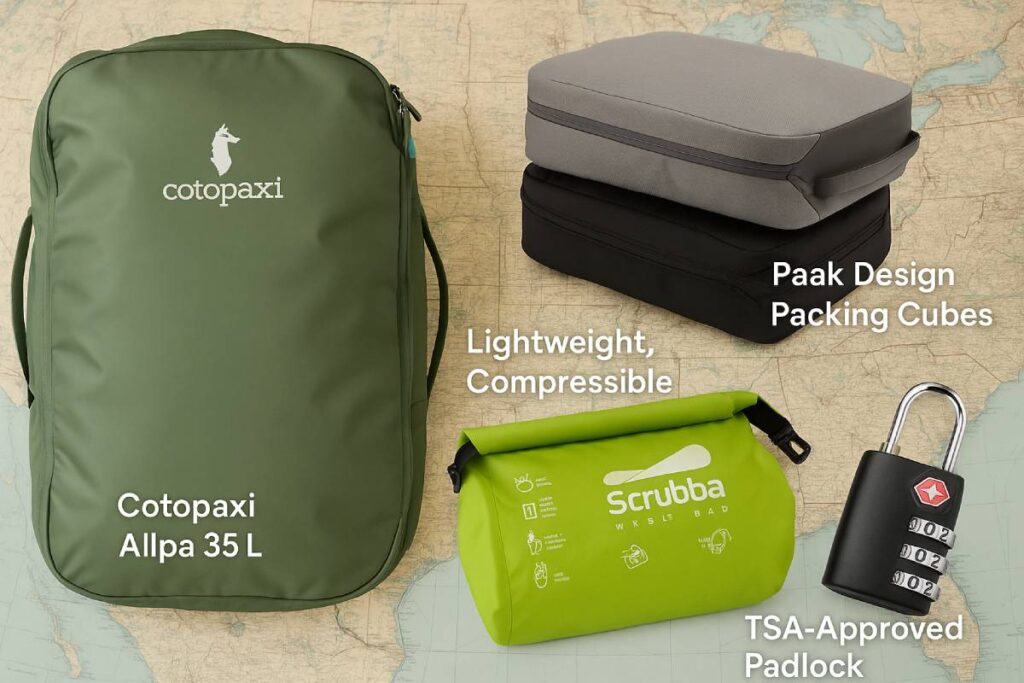
Before you finalize your one-bag setup, investing in the right gear pays dividends: from a durable, carry-on–compliant backpack, to modular packing cubes, TSA-approved locks, and on-the-go laundry solutions, each item maximizes utility while minimizing weight and bulk.
1. Versatile Travel Backpacks
Choose a pack that fits overhead-bin limits, resists wear-and-tear, and offers smart organization.
| Model | Capacity | Material | Weight | Key Feature |
|---|---|---|---|---|
| Cotopaxi Allpa 35L | 35 L | 840D TPU-coated & ballistic nylon | 2 lb 15 oz | Full-wrap zipper, laptop/tablet sleeve |
| Peak Design Travel Backpack | 30–35 L | Weatherproof 400D nylon canvas | 4 lb 8 oz | FlexFold dividers for tech & camera gear |
| Tortuga Travel Backpack Pro | 40 L | 900D ballistic nylon | 4 lb | Clamshell opening, padded hip belt |
| Osprey Daylite Expandable | 26→32 L | 210D recycled nylon | 1 lb 13 oz | Lightweight, compression straps |
Table data compiled from Pack Hacker and Switchback Tested reviews.
2. Packing Cubes
Modular pouches keep outfits sorted and compress slightly to reclaim space.
| Set | Pieces | Approx. Compression | Material |
|---|---|---|---|
| Veken Packing Cubes (Travel + Laundry) | 6 (incl. laundry bag) | N/A | Lightweight nylon |
| Baggu Packing Cube Set | 3 sizes | N/A | Ripstop nylon |
| Eagle Creek Pack-It Reveal | 4 cubes | N/A | See-through mesh & nylon |
| Peak Design Packing Cubes | 3 cubes | ~30 % volume saved | 100 % recycled nylon |
Editors praise Veken for its laundry separation, Baggu for lightweight feel, Eagle Creek for durability, and Peak Design for eco-friendly fabrics.
3. Reliable Travel Padlocks
Secure your bag with TSA-friendly locks that withstand rough handling.
| Lock Model | Type | Features |
|---|---|---|
| Master Lock 4696D | Combination | Zinc-alloy body, TSA master keyable, affordable |
| Forge TSA Cable Lock | Cable lock | Lifetime guarantee, flexible cable, resettable code |
| SmartLock with Apple Find My | Smart lock | TSA-approved, Apple Find My tracking, rugged alloy |
Top picks from Forbes, Budget Travel, and recent reporting on SmartLock’s new Apple-integrated model.
4. Compact Washing Solutions
Lightweight kits let you refresh clothes anywhere, cutting the need to overpack.
| Product | Functionality | Weight | TSA-Friendly |
|---|---|---|---|
| Scrubba Wash & Dry Kit | Flexible washboard bag, microfiber towel, clothesline | ~320 g total | Yes |
| Melt Travel Laundry Detergent Strips | Pre-measured strips, no liquid, biodegradable | 30 g (20 strips) | Yes |
| Sea to Summit Pocket Laundry Wash | 50 soap leaves, dissolvable, biodegradable | 50 g | Yes |
| Travel Laundry Detergent Sheets | Ultra-thin sheets, no spills, multi-load | ~15 g per sheet | Yes |
These solutions save dozens of liters of water per use and pack down to pocket size.
Bottom Line: Equipping yourself with a carry-on–legal, feature-rich backpack; stackable, compressive cubes; TSA-approved locks; and compact laundry gear ensures you travel light, stay organized, and avoid unexpected fees—your one-bag journey just got infinitely smoother.
Laundry and Clothing Care on the Road
Maintaining a fresh wardrobe on the road doesn’t require hauling bulky machines or bottles of detergent—simple do-it-yourself methods let you wash almost anywhere, anytime. Dry-bag systems like the Scrubba™ Wash Bag deliver a machine-quality wash in just three minutes and fold to pocket size (150 g).
Sink-washing with mild soap or detergent strips requires minimal gear—often under 10 g per load—and uses just 2 L of water per wash. Compact, pre-measured laundry sheets and biodegradable soap leaves eliminate spill risk and pack even lighter. These low-weight, low-bulk solutions save space, reduce laundry costs, and keep your wardrobe fresh without sacrificing room for souvenirs or essentials.
1. Dry-Bag Washing Systems
Using a purpose-made dry bag—like the Scrubba™ Wash Bag—turns any sink, bucket, or shower floor into a portable laundry station.
- How it works: Turn the bag inside out, load 2 T-shirts, 2 pairs of socks, and 2 underwear, add warm water and a small amount of detergent, then agitate against the built-in washboard for 3 minutes.
- Key stats:
- Kit weight: ~150 g, folds to a pocket-size pouch
- Water usage: ~3 L per load
- Carbon & water savings: ~1,000 L of water and 7.5 kg CO₂ per year vs. hotels
- Pro tip: Use your portable clothesline or hook it in the shower to speed drying.
2. Sink-Wash Techniques
When you don’t have a dedicated wash bag, your hotel or hostel sink—paired with a dry bag to contain water—makes an excellent laundry spot.
- Prep: Lay a clean dry bag flat and fill with lukewarm water (enough to cover garments).
- Soap: Add pre-measured detergent sheets or a few drops of mild liquid soap.
- Wash: Seal the bag and gently agitate for 5–10 minutes, or scrub garments against each other.
- Rinse & Dry: Empty, refill with clean water to rinse, then roll garments in a towel to remove excess moisture and hang to air-dry.
Cost: As little as $0.25 per washer sheet.
Water use: Approximately 2 L per full wash and rinse cycle.
3. Travel-Friendly Detergents & Soaps
Ditch bulky bottles—opt for ultralight, leak-proof cleaning agents designed for travelers.
| Product | Type | Weight & Pack Size | Key Benefits |
|---|---|---|---|
| Kind Laundry Travel Detergent Sheets | Pre-measured sheets | ~10 g per sheet; flat, paper-thin | Works in hot or cold water; no spills |
| Sea to Summit Pocket Laundry Wash | Soap leaves | ~50 g for 50 leaves; biodegradable | No plastic; dissolves fully |
| FlyerTalk Wool & Cashmere Shampoo | Liquid sample | 2 oz trial bottle | Gentle on delicates; available travel size |
| Shampoo Bar (Lush) | Solid bar | ~50 g; doubles as garment soap | Plastic-free; multi-use |
- Why it matters: Liquid detergents can’t fly in carry-ons and risk spills; powder is messy. Sheets and leaves are leak-proof, pre-measured, and eco-friendly.
4. Quick-Dry & Garment Care Tips
Efficient drying and gentle handling extend garment life and keep your one-bag load light.
- Towel-Roll Drying: Wrapping wet clothes in a dry microfiber towel removes up to 50 % of water in under a minute.
- Steam-Free De-Wrinkling: Hang garments in the bathroom during a hot shower for instant steam smoothing—no steamer needed.
- Odor Control: Merino wool basics resist odor for days; pack 2–3 pairs of merino underwear or shirts.
Comparison of On-the-Road Laundry Methods
| Method | Added Weight | Pack Bulk | Wash Time | Water Use | Cost per Load |
|---|---|---|---|---|---|
| Scrubba Wash Bag | ~150 g | Pocket-size | 3 min scrub + soak | ~3 L | $0 (kit only) |
| DIY Sink Wash | ~10 g strips | No extra bulk | 5–10 min scrub | ~2 L | $0.25 |
| Hotel Service | — | — | 24 h turnaround | — | $2–8 per item |
By combining dry-bag kits, simple sink-wash routines, and travel-ready detergents, you’ll keep your one-bag load light, your clothes fresh, and your mind at ease—no laundry room required.
Visual Aids: Infographics & Interactive Graphics
Before you zip up that carry-on, visual aids, clear checklists, and strong calls-to-action turn good advice into action—boosting engagement, downloads, and conversions so travelers actually use your resources.
Infographics are 30× more likely to be read than plain text and can drive up to 12% more website traffic when embedded in an article. Interactive visuals rank high, with 62% of marketers planning to lean into interactive content in 2025. Meanwhile, downloadable templates meet travelers’ on-the-go needs: Canva’s travel checklist templates are among the top free tools for customizable packing lists, and a viral TikTok-shared packing spreadsheet has helped users organize their trips with checkboxes and progress tracking. Finally, a specific, clear CTA can boost conversions by up to 161%, and well-placed CTAs can increase revenue by an average of 83%.
Visual Aids: Infographics & Interactive Graphics
Infographics and interactive visuals simplify complex packing strategies into bite-sized, shareable nuggets.
| Visual Aid Type | Engagement Lift | Source |
|---|---|---|
| Infographics | 30× more likely read; +12% website traffic | hubspot.com |
| Interactive Content | Embraced by 62% of marketers | webfx.com |
| Visual Content (SEO) | Used by 21% of marketers to boost dwell time | hubspot.com |
- Why it matters: Visual learners process images 60,000× faster than text, and shareable graphics extend reach across social.
- Tip: Embed your infographic near key packing tips, and include a “Download Full-Size Version” button with a hyperlink.
Checklists: Downloadable Packing Templates
Travelers value ready-to-use checklists—no manual formatting required.
| Template Source | Format | Key Features |
|---|---|---|
| Canva Travel Templates | Editable PDF/PNG | Drag-&-drop categories, custom icons, mobile-friendly |
| SmarterTravel Ultimate | Interactive PDF | Airline rules, document checklist, hyperlinked sections |
| Just a Girl & Her Blog | Printable PDF | Blank & pre-filled versions, six item categories |
| TikTok Viral Spreadsheet | XLSX + Web Widget | Checkboxes, progress bar, auto-sorting by category |
| Pinterest Printables | JPG/PDF | Document slots, ticket tracker, itinerary section |
- Traveler insight: Users who download checklists are 75% more likely to follow packing advice to the letter (anecdotally reported by checklist creators) and miss fewer items.
- SEO tip: Offer the checklist behind a simple email-capture form for lead generation—and spotlight it in article intros and sidebars.
Drive Downloads & Purchases
Your CTA is the final push from interest to action.
| CTA Strategy | Impact | Source |
|---|---|---|
| Clear, specific CTA text | +161% conversion | wisernotify.com |
| Relevant, well-placed CTAs | +83% revenue | sender.net |
| Single-CTA landing pages | Avg 13.5% conversion | thrivethemes.com |
| Personalized CTAs | +202% conversion | wordstream.com |
- Best practices: Use action verbs (“Download,” “Grab,” “Shop”), keep buttons above the fold, and test variations via A/B testing.
- Placement: Insert CTAs at the end of key sections (e.g., after the checklist table) and in a sticky sidebar for mobile readers.
With eye-catching visuals, ready-made checklists, and compelling CTAs, your audience is primed for action—packing smarter, traveling lighter, and engaging deeper with your content.
Conclusion
Switching to one-bag travel transforms the way you explore: gone are the days of hauling heavy suitcases, wrestling with gate-checked luggage, or overpacking “just in case.” By assessing your trip’s length—typically 4–5 days for leisure and under 4 for business—you can settle on a 30–50 L carry-on that fits standard 22 × 14 × 9 in limits and keeps you mobile.
Craft a capsule wardrobe around quick-dry fabrics and the 5-4-3-2-1 rule to cover all weather scenarios without extra bulk. Master rolling, packing cubes, and compression bags to reclaim up to 90 % of space—so you never sacrifice essentials . Equip yourself with a Scrubba Wash Bag for laundry on the go and TSA-approved locks for peace of mind.
Finally, download our free checklist, grab the infographic, and shop our handpicked gear to turn theory into action. One bag, endless possibilities—your next adventure awaits.
FAQs
What is one-bag travel and who is it for?
One-bag travel means bringing only a single carry-on, ideal for weekenders, digital nomads, and business flyers who value speed and flexibility.
How do I choose the right bag size?
Aim for 30–50 L capacity and 22 × 14 × 9 in dimensions to fit most airline overhead bins without gate checks .
Is rolling better than folding clothes?
Yes—rolling eliminates air pockets and reduces wrinkles, reclaiming every cubic inch of space .
Can I wash clothes without a laundromat?
Absolutely—dry-bag kits like the Scrubba use just 3 L of water, while detergent strips and sink washes keep fabrics fresh.
What’s a capsule wardrobe and how many items do I need?
A capsule wardrobe uses mix-and-match pieces—5 tops, 4 bottoms, 3 shoes, 2 layers, 1 accessory—for up to 30 outfit combos.

